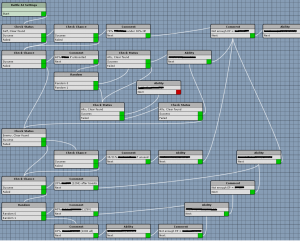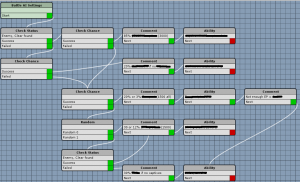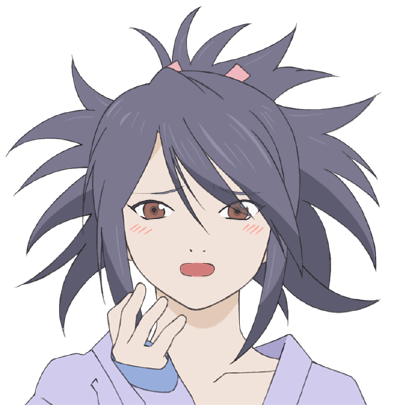Last week’s achievements
* Made functional ally-summoning enemies
* Tested out EarthBound-style HP drain and inadvertently figured out how to do Pokémon-style HP bars
* Tested out one-turn-delay priority attacks
Current focus
Touching up various features.
Weekly goals
* Send art feedback for final Winter design
* Integrate animations with ORK
* Make the 2D camera follow the player
* Design layouts for Seaside Slime Cove, Den of Kobolds and the Unicorn, Spring Lake Valley
* Write bestiary flavor text for remaining enemies
Comments
Since I’ve been on animation for a while, I jumped back into tweaking the battle system for the past week (aside from visiting family for Thanksgiving). Somewhere in the ether exists an incredible RPG, simply waiting to be created, with priority attacks that change turn order on a one-turn delay, but I feel that the entire game would have to be built around that mechanic with methodical and strategic battle pacing. It’s kind of like Flamberge, a recent Kickstarter strategy RPG where both sides take their turns simultaneously: a very interesting idea that demands an RPG’s full attention and commitment.
(I will say this: if delayed priority was going to make sense in any game, then it might have to be one with physics like mine where everyone has super speed; mechanically it feels sort of like the turn-based version of bullet time.)
And then there’s EarthBound HP drain. Though it’s a great mechanic for adding some real-time flavor to turn-based battles, it turns out that most of the reason why it works is because that series, like its inspiration Dragon Quest, has very easy decision-making. My decision-making is more akin to competitive Pokémon, so rolling HP either puts too much pressure on players if it’s fast or looks silly if it’s slow.
It also conflicts with my Last Stand battle mechanic, where a character at 0 HP loses EP until finally going down (basically like a certain showdown in Final Fantasy V, but active in every boss battle); because they’re similar concepts, Last Stand gets lost in the shuffle if HP also drains that way under normal conditions. I still love the idea of HP drain, but like with delayed priority, an RPG needs to be built around it. The good news is that now I know how to do justice to Pokémon HP bars!
That brings me to the bigger success of the week: enemies can summon allies now! They’ll mainly come in two varieties of summoning multiple fragile enemies or single strong ones, but a certain puzzle-esque “boss” also has her own spin on the idea. I didn’t keep many ideas from 1999-2001-era Me without major tweaking—not even my magnum opus boss battle—but that one’s staying mostly unchanged. =)
Anyway, of the first continents’ enemies, Kobold Chiefs are the best at summoning because they can give party-wide stat boosts to whatever they summon. Kobold Rogues used to outshine them since they could (and usually do) blind the player party, but now there’s real choice in deciding whether to go after Chiefs or Rogues first. And worse yet are the Chiefs who have tamed Greatwolves. Greatwolves only call more of their pack when they’re weak, so one might try to leave them alone, but their stats are almost as good as party members, they can be buffed by Chiefs too, and they can pin party members to take away their turns and feast on them for massive HP recovery like those cannibalistic hydras in the final dungeon of Chrono Trigger.
Ahhh… If it isn’t obvious, this is the stuff I love talking about in these updates. ♥ If I had any good business sense then maybe I’d find somebody and pay them to figure out all the animation stuff and create maps while I do what I like, but I do appreciate knowing what is and isn’t difficult in this process. So back to that I go!
One last note:
It’s a crazy thing to find yourself singing along to a piece of music when you’ve never heard it before, but I actually have heard it before. : D Going back to things from an earlier era that I’ve thrown away, the story of my RPG’s 2001 version opened with the heroine wondering whether people dream of adventure for a reason and launching into a solo musical number about loving her steady life but still wanting more.
I was 16 and so the lyrics are mostly embarrassing and I’m not posting them now—except for the ending. I haven’t thought of that song in years upon years, but the first time I heard 0:20 of that Pokémon Omega Ruby and Alpha Sapphire theme, the two repeated choruses came rushing back to me:
And I think I will find—no, I’ll find out, I know
What awaits me if I just move onThere is loving and living and so much I’ll never know
Until I’m out exploring what’s beyond
And so very soon, I’m sure, I am going to find
What awaits me if I just move on
The bold part has almost the same cadence as the Pokémon piece except that it pauses before “no” instead of before “me”; the notes and scale of the first line in particular are exactly what I had in mind way back when. <3 It also fits even better with the “And so very soon, I’m sure” line other than having one fewer note. Sometimes I write lyrics for pre-existing game songs for fun, but this might be the one and only time where things happened in reverse. =P



